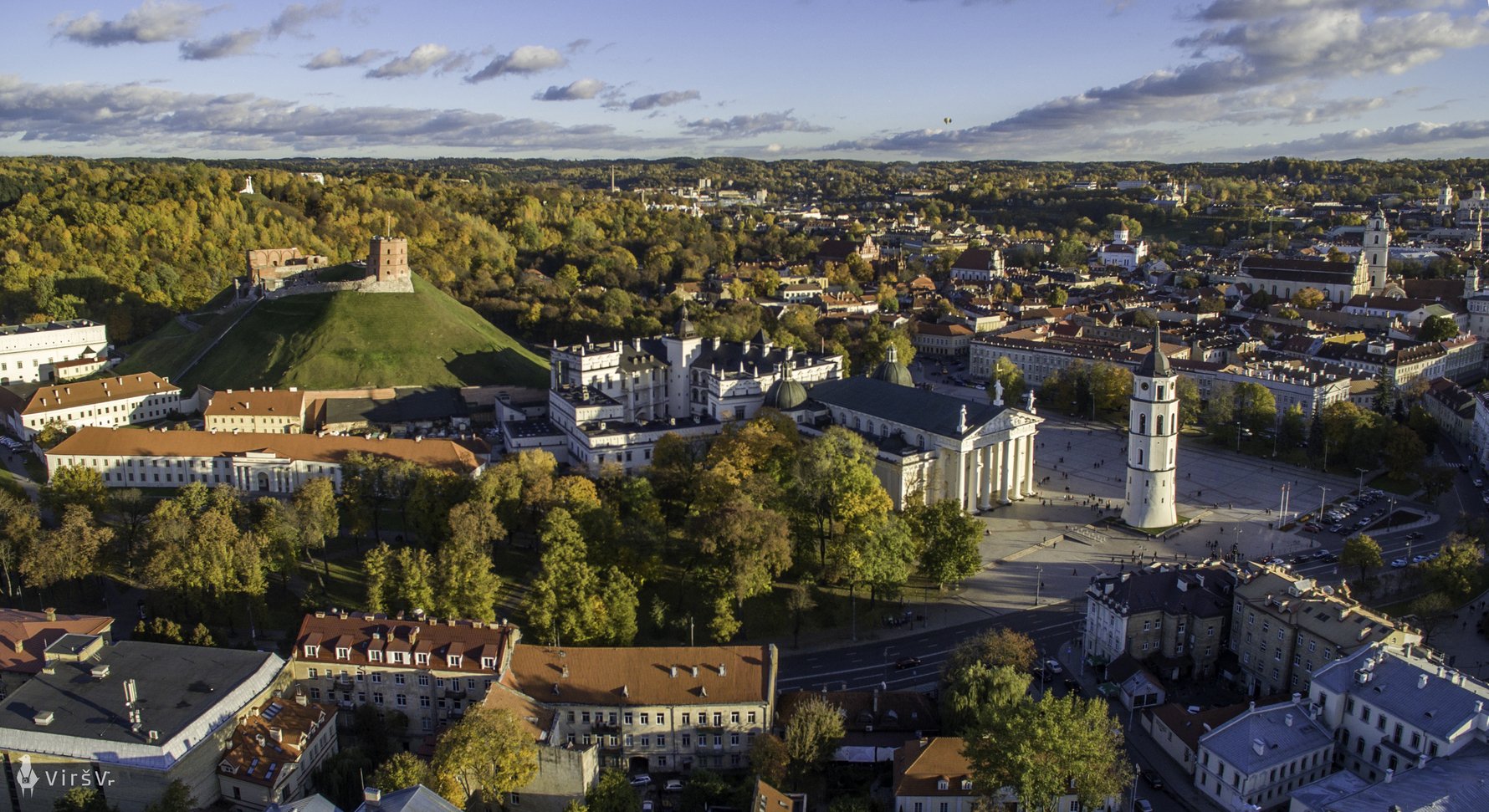The Lithuanian state arose and strengthened to counter the religious fervour of crusading German knights. Lithuania was the last European country to convert to Christianity, and has seen countless invasions and occupations over the centuries.
7th-2nd centuries BC
The first Baltic tribes establish themselves on what’s now known as Lithuanian territory.
11th century
The word Lithuania is first used in written texts in AD1009. At the same time, a wooden castle is built on Vilnius’ Gediminas Hill (Gedimino Kalnas), leading to the construction of a diminutive settlement beneath it.
13th century
Žemaitians defeat the Livonian Knights at the Battle of Saulė in 1236, establishing the settlement of Šiauliai. After uniting local chieftains, on July 6, 1253 Mindaugas (circa 1203-1263) is crowned Lithuania’s one and only king. During his reign as the first Christian sovereign of the state, Vilnius Cathedral is built. However, the majority of the population remains pagan.

14th century
In 1323 Grand Duke Gediminas (circa 1275-1341) sends letters to various Germanic-speaking towns, inviting their craftsmen and merchants to settle in Vilnius with the promise of religious freedom. Trying to ensure peace, in 1325 he forms a union with Poland by marrying his daughter Aldona to the Polish king’s son. The Polish-Lithuanian Commonwealth comes into being with the 1387 Krėva Union, whereby Gediminas’ grandson Jogaila (circa 1348-1434) becomes a Polish king by marrying the Polish Princess Jadwiga (circa 1373-1399). Even with the increased security, the Teutonic Knights still manage to invade, resulting in the 1390 burning of the wood-constructed Vilnius.
15th century
The Teutonic Knights are eventually defeated onJuly 15, 1410 by joint Polish-Lithuanian armies led by Jogaila and Grand Duke Vytautas (1350-1430) at the Battle of Grunwald (Lithuanian, Žalgiris. German, Tannenberg), one of the greatest battles in medieval Europe. The country flourishes and by 1430 the borders extend from the Baltic to the Black Sea.
16th century
The Renaissance sees marked cultural advances, notably the printing of the first Lithuanian book in1547, and the founding of Vilnius University in1579. The end of the Jogaila dynasty in 1572results in the political and cultural marginalisation of Lithuania. Polish becomes the state language. The Livonian Wars (1558-1582) with Russia and Sweden drain the Commonwealth’s resources.
18th century
At the start of the 18th century both Swedish and Russian forces try to seize control of Vilnius. In1795 Lithuania is incorporated into tsarist Russia. The 120-year Russian occupation is only interrupted by a short liberation by Napoleon’s army in 1812 on his failed campaign to Moscow. During the Napoleonic army’s return through Vilnius nearly 40,000 of his soldiers die due to starvation and extreme cold.
19th century
Vilnius University acts as a hotbed of dissent against the tsarist government, culminating in the1831 November Uprising, which leads to the closing of the institution. Russification ensues with non-Orthodox churches forcibly closed, the Lithuanian language banned in 1864 and the country named the Northwest Region. The ban on the Latin script forces the smuggling in of books from neighbouring East Prussia. Another uprising takes place in 1863 and General Muravyov (The Hangman) is sent from Moscow to restore order, resulting in deaths by hanging for most of the leading activists. The repression is countered and defied by a revival of Lithuanian culture and tradition. In 1883 Jonas Basanavičius (1851-1927) publishes the first Lithuanian-language newspaper, Auszra (Aušra, or Dawn).
20th century
During the WWI German occupation of 1915-1918 the Lithuanian Council proclaims independence on February 16, 1918. As the Germans retreat, the Lithuanian state comes under attack by the Polish General Józef Piłsudski (1867-1935) who seizes control of Vilnius and areas south of it from1920-1939. Poland maintains control of these areas by claiming they were a portion of the pre-war Polish-Lithuanian Commonwealth. Kaunas becomes the interim capital of Lithuania until1940. During the inter-war period independent Lithuania prospers under the 14-year dictatorship (1926-1940) of the nationalist president Antanas Smetona (1874-1944). Lithuanian independence ends with the clandestine signing on August 23, 1939 of the Molotov-Ribbentrop Pact between Hitler and Stalin, who carve up Europe into portions to be controlled by Nazi Germany and the Soviet Union. Lithuania is subject to both Soviet and Nazi occupation. Between 1941-1944the Nazis and their Lithuanian henchmen organise the mass murder of over 200,000 Jews, 94% of the entire Litvak population. The return of the Red Army and the re-incorporation of Lithuania into the USSR on July 7, 1944 results in the deportation of some 250,000 Lithuanians to Siberia, a task they’d already begun in1940 before the Nazis arrived. Lithuanian partisans, dubbed the Forest Brothers (Miško Broliai), wage guerrilla warfare until 1953. In an act of protest against the Soviet occupation, onMay 14, 1972 19-year-old student Romas Kalanta sets fire to himself in public in Kaunas, dying from his wounds.
Independence & Beyond
1988
June 3 The Lithuanian reform movement Sąjūdis is founded by some 500 representatives of the intelligentsia, advocating openness, democracy and sovereignty. August 23 Some 250,000 people gather in Vilnius to mark the 49th anniversary of the Molotov-Ribbentrop Pact.October 7 The Lithuanian flag is raised on Gediminas Castle.
1989
August 23 An estimated 2,000,000 Lithuanians, Latvians and Estonians join hands in a human chain stretching the 650km between Vilnius and Tallinn to protest the 50th anniversary of the Molotov-Ribbentrop Pact.
1990
January 11-13 Mikhail Gorbachev’s visit to Vilnius is far from pleasant as 300,000 pro-independence demonstrators turn out to ‘welcome’ him. March 4 Pro-independence Sąjūdis candidates win a majority in the first free elections in Lithuania since 1940. March 11 The Supreme Council (later Parliament, or Seimas) declares the restoration of Lithuanian independence and demands the withdrawal of Soviet forces. Vytautas Landsbergis is elected parliamentary chairman. April 17 Moscow imposes an economic blockade.
1991
January 13 Soviet forces try unsuccessfully to storm the parliamentary building in Vilnius. A large crowd ensures the delegates are safe inside. However, in a violent bid to reclaim the media by storming the Television Tower, 14 people are killed. February 12 Iceland becomes the first country to recognise an independent Lithuania. July 31 Seven border guards and policemen are killed at the Medininkai border checkpoint by Soviet special forces. August 21 The Moscow putsch collapses. Soviet troops leave the buildings they’ve occupied since January. Lenin’s statue is removed from Vilnius’ Lukiškių Square. A photograph of the event appears on the cover of Issue N°1 of Vilnius In Your Pocket, published on May 1, 1992. August 29 Sweden becomes the first Western country to open an embassy in Vilnius.September 2 The USA recognises Lithuania, Latvia and Estonia. September 17 All three Baltic countries are re-admitted into the UN.
1992
February 8 Lithuanians participate under their own flag at the Winter Olympics for the first time since 1928.
1993
June 25 Lithuania’s pre-war currency the litas is re-introduced. August 31 The last Russian soldier leaves Lithuania. September 4-8 Pope John Paul II visits.
1994
December Vilnius’ Old Town joins the list of Unesco World Heritage sites.
1998
January 4 Valdas Adamkus is elected president. Adamkus, who fled Lithuania in 1944, was a senior official at the US Environmental Protection Agency before returning to Lithuania to run for president. December 21 Seimas abolishes the death penalty in response to international pressure from the EU.
1999
December 13 Accession talks begin between Lithuania and the EU with a projected date of 2004. A major stumbling block is the decommissioning of the Ignalina Nuclear Power Plant.
21st century
2004 January-April Impeachment hearings take place as the new right-wing president Rolandas Paksas is found guilty of violating the constitution in his alleged dealings with unsavoury Russian business partners. April 2 Lithuania becomes a fully-fledged member of Nato, and then of the EU on May 1. December 31 The Ignalina Nuclear Power Plant says farewell to the first of its two Chernobyl-style RBMK reactors. It finally closes at the end of 2009.
2009 Lithuania celebrates 1,000 years since its name was first mentioned in written texts. Dalia Grybauskaitė is inaugurated as the country’s first female president on July 12.
2013 Lithuania takes over the Presidency of the Council of the European Union for a six month period from July 1.
2014 May Dalia Grybauskaitė is re-elected president of Lithuania.
2015 January 1 Lithuania adopts the euro.
2018 February 16 Lithuania stages huge celebrations to mark 100 years since the restoration of its independence in 1918.




